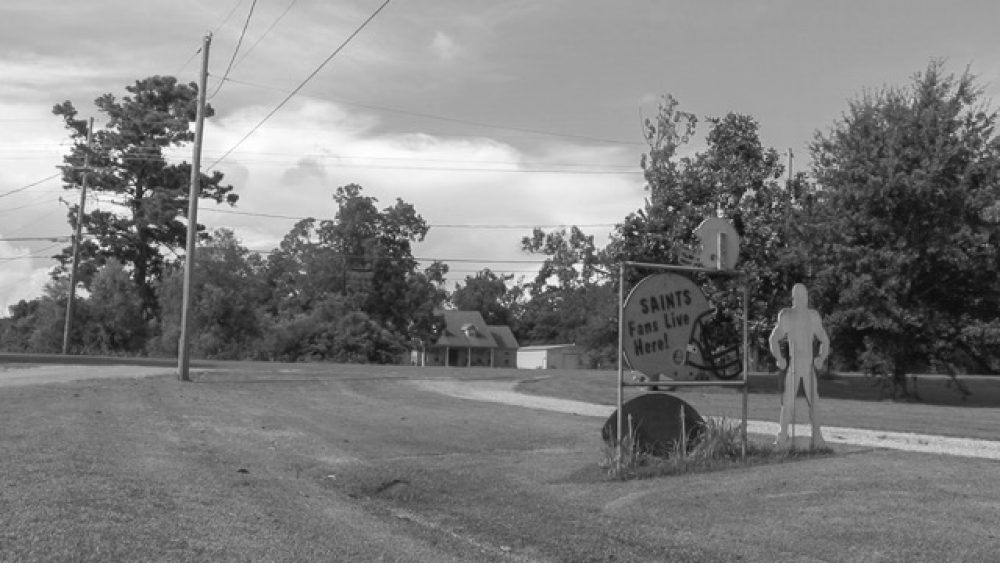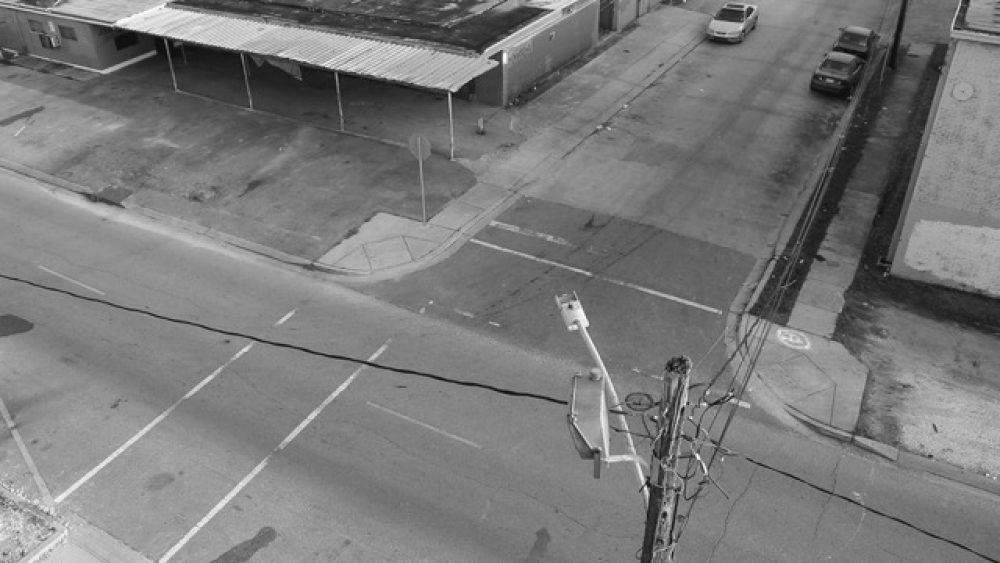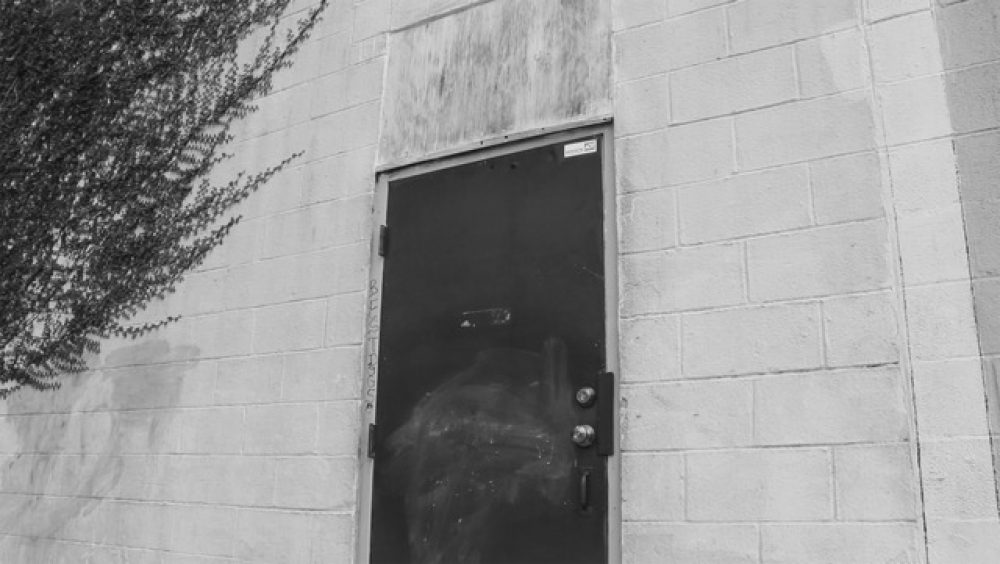Meeting Eulalie
Artist and PARSE resident Casey Ruble gives a preview of her forthcoming documentary film, which is inspired by the story of Eulalie Mandeville.

When Eulalie Mandeville was a young woman, her father, Pierre Philippe Mandeville de Marigny, gave her two tracts of land in what is now Chalmette. She was raised on her grandmother’s plantation nearby. A still from footage for Casey Ruble’s Eulalie. Courtesy the artist.
In 1774, a child was born to an enslaved mother and the largest white landowner in Louisiana. Emancipated at age five by her grandfather for “the good services received from her mother” and “the love and affection I have for one born in my household,” she was raised by the aristocratic Mandeville de Marigny family.1 She went on to become one of the wealthiest free women of color in New Orleans.
Her name was Eulalie.
If you ask genealogists how they became interested in researching a particular ancestor, they may tell you that you’ve got it backwards: It wasn’t they who became interested; it was the ancestor who wanted her story told and sought out someone to do it. (To this community, the dead are anything but.) I find it hard to believe that Eulalie Mandeville would pick me, someone descended from early New England colonizers and Kentucky country folk, to tell the story of her life, but the moment I crossed paths with her, I knew I had to try.
I first came across Mandeville during a short stay in New Orleans in February of this year, when Amy Mackie, director of the curatorial residency and non-profit art program PARSE, invited me to tour the organization’s headquarters, situated in an elegant Greek Revival house in the Marigny, the faubourg that Mandeville’s half-brother, Bernard Marigny, founded. As we stood on the balcony off what would later become my bedroom, Mackie offered a brief history of the property: Its most recent owner had been Fred Bookhardt—an architect who was also a gifted artist, mathematician, and storyteller. (His brother, D. Eric Bookhardt, an art writer and president of the Center for Gulf South History and Culture, inherited the house in 2015.) In the 1970s, the house had been bought by a man who meticulously restored it from its previous incarnation as a flophouse. Before that, it had been a bakery, and, according to a 2010 master’s thesis written for the Department of Planning and Urban Studies at the University of New Orleans, the property had once belonged to Mandeville.

The site of one of the Mandeville de Marigny plantation homes, at the foot of Elysian Fields Avenue. It is now home to Bubba’s Produce. A still from footage for Casey Ruble’s Eulalie. Courtesy the artist.
Upon returning home to New Jersey, I drew up a proposal for a project that would investigate all the past inhabitants of the property. But the further I got into my research on Mandeville, the more fascinating her story grew. I began to realize its potential to serve as an allegory of a nation bound together in both love and war, with all the contradictions that union has spawned.
For nearly a decade my work has focused on under-told histories—most recently on race riots and rebellions from the past 200 years. I am deeply interested in stories that complicate the mainstream narrative of our country as a land of opportunity and freedom. Mandeville’s life draws a picture of the barbarism of slavery and oppression, but also of love, resistance, and strength. That the thriving and racially integrated New Orleans Creole community of which she was a part suggested a nascent, if imperfect, model for egalitarianism in our country is a fact that’s largely left out of the history books. My past work has investigated these kinds of hidden histories through the mediums of painting and paper collage, but this project kept whispering that it wanted to be a documentary film—one that would borrow stylistically from the tradition of silent cinema, with footage shot in black and white and the narrative conveyed solely through text panels. I decided to oblige it.
Four months after my February meeting with Mackie, I was back in New Orleans, poring over yellowed pages in the Notarial Archives on Poydras Street; perusing the Index of Sacramental Records on the third floor of the public library’s main branch; scouring historical maps and wading through microfiche newspaper articles at the Historic New Orleans Collection’s Williams Research Center; and navigating the byzantine archives of various law libraries. I racked up credit-card debt at Octavia Books and bought a new pack of highlighters at CVS to help annotate my growing library. Most importantly, I met with dozens of historians, genealogists, scholars, filmmakers, and descendants of both the Mandeville de Marigny family and the family of Eugène Macarty, the white man who became Mandeville’s life partner. These individuals provided a crucial layer of information that textbooks never can: Their vocal cadence and tone, their particular vocabularies, where they paused for emphasis or in hesitation—all spoke volumes about the different ways we interpret the facts of the past, through lenses of outrage, guilt, nostalgia, denial, pride, and everything in between.

Power lines knit the sky above the Elysian Fields Avenue plantation site. A still from footage for Casey Ruble’s Eulalie. Courtesy the artist.
It was sometime in her late teens that Mandeville formed a relationship with Eugène Macarty; she went on to have seven children with him by her early 40s. Maybe it was love; maybe it was a strategic alliance; probably it was both. Macarty brought a pedigreed ancestry to the union—his Creole family was large, wealthy, and powerful. The fact that he had no financial assets of his own did not deter Mandeville: Her family had given her land, slaves, and money, which she used to build a lucrative dry-goods business that reached as far north as Donaldsonville and as far west as Attakapas Parish (now St. Martin and St. Mary Parishes),2 areas that today are still covered by sugarcane fields. Macarty used the proceeds from Mandeville’s business in his brokerage dealings, offering loans at high interest to other New Orleanians, and the couple amassed an estate worth over the equivalent of three million dollars today.3 When Macarty died in 1845, members of his family—including the infamous Madame Lalaurie, who was run out of New Orleans for torturing her slaves—took Mandeville to court, claiming they were the rightful heirs to the estate. A century later, a great-great-grandnephew of Macarty filed a similar suit.4 Though the cases ended very differently, both reveal how ill-equipped the law was to contain or contend with the fluidity of race.
Mandeville was born just two years before the Declaration of Independence was signed. At that time, Louisiana was still a foreign country, governed by the comparatively permissive laws of Spain. She’d given birth to four children by the time Louisiana was transferred to American rule, and to six by the time it became a state. As she built her family and business, she also witnessed the strangulation of freedoms for non-enslaved people of color in the decades leading up to the Civil War. She died in 1848, just months after the ruling came down on the case against her. Two of her sons lived long enough to see the beginning of the Civil War, and one of them lived to see both the end of it and the subsequent expansion of rights for people of color with the 13th, 14th, and 15th Amendments. He died a few months after the removal of federal troops from the South obliterated the gains that had been made, effectively ending Reconstruction.

Eulalie Mandeville’s son Pierre Villarceaux Macarty died a wealthy man in 1878. He bequeathed one of his many properties—a lot bounded by what are now Chartres, Mandeville, Decatur, and Marigny Streets—to four of his “old domestics and servants,” individuals who had probably been his slaves before the Civil War. A still from footage for Casey Ruble’s Eulalie. Courtesy the artist.
Only two of Mandeville’s children—both of whom migrated to Cuba5—had children of their own. Most of her grandchildren ended up in Europe, primarily in France,6 where the trail of her descendants has, for now, gone cold. But transcripts from the 1953 legal case brought here in America by Eugène Macarty’s great-great-grandnephew tell a vivid story about the terrorism of Jim Crow, which prompted some biracial people to begin identifying as white, others to embrace their African lineage, and still others to attempt to articulate a more hybrid self that the law was loathe to recognize.7
My film, which is still in progress, is broken into chapters on some of these members of the Mandeville-Macarty family. It also explores the idea of place: Rather than relying on historical footage, I decided—as I have done in my previous work—to depict sites of importance to Mandeville’s life as they appear today. On many mornings during my stay at PARSE, I was out of the house by 6 am, camera in hand, recording these places: the location of one of the Mandeville de Marigny plantation homes,8 now a warehouse for Bubba’s Produce at the foot of Elysian Fields; the two strips of land Mandeville was given in what is now Chalmette, which she leased for cutting timber to Eugène Macarty9; the site of his family plantation home, now a fitness center and a few rows of shotgun houses in the Bywater.10 These mornings were mostly quiet, the sun burning silently through the haze, punctuated by the hiss of street-cleaning vehicles and the occasional monologue of a drunk staggering home at dawn.
New Orleans has long been a place both part of and separate from the rest of our country—a contradiction epitomized by Mandeville’s story. Revealing how history is embedded in the landscape but also erased from it, Eulalie will be a meditation on family, race, and our nation’s struggle to define itself during two centuries of extreme flux.
Notes:
- Acts of Andres Almonester y Roxas, November 9, 1779. See also: Carolyn Long, “The Macarty Family in Orleans Parish: Part II,” New Orleans Genesis, no. 203 (July 2013): 201.
- Second District court records for Nicolas Théodore Macarty et al v. Eulalie Mandeville f.w.c., docket no. 195, filed with Supreme Court of Louisiana docket no. 626. Accessed via the Supreme Court Historical Archives, Louisiana and Special Collections, Earl K. Long Library, University of New Orleans.
- Ibid.
- Supreme Court of Louisiana court records for Successions of Victor St. Amand, Raoul St. Amand, George St. Amand, Rubert St. Amand, Jr., Lucine St. Amand, and Laure St. Amand, Consolidated with Succession of Adele St. Amand, docket no. 40,833. Accessed via the Law Library of Louisiana.
- Nicolas Théodore Macarty et al v. Eulalie Mandeville f.w.c.
- Succession of Pierre Villarceaux Macarty, filed August 30, 1878. Accessed via the Wills and Probate Records section of www.ancestry.com.
- Successions of Victor St. Amand, Raoul St. Amand, George St. Amand, Rubert St. Amand, Jr., Lucine St. Amand, and Laure St. Amand, Consolidated with Succession of Adele St. Amand.
- “Living with History in New Orleans’ Neighborhoods: Faubourg Marigny,” Preservation Resource Center of New Orleans. Accessed via prcno.org.
- Nicolas Théodore Macarty et al v. Eulalie Mandeville f.w.c.
- “Judicial Sales—Estate of the late Louis Barthélémy Macarty,” The New Orleans Bee, May 14, 1847. See also: Carolyn Long, The Macarty Plantation Lands in New Orleans’ Bywater Neighborhood, unpublished manuscript.



